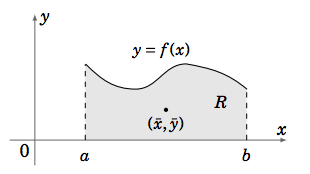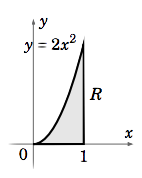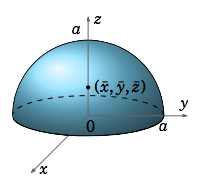3.6: Application- Center of Mass
( \newcommand{\kernel}{\mathrm{null}\,}\)
Recall from single-variable calculus that for a region R=(x,y):a≤x≤b,0≤y≤f(x) in R2 that represents a thin, flat plate (Figure 3.6.1), where f(x) is a continuous function on [a,b], the center of mass of R has coordinates (ˉx,ˉy) given by
ˉx=MyM and ˉy=MxM
where
Mx=∫ba(f(x))22dx,My=∫baxf(x)dx,M=∫baf(x)dx
assuming that R has uniform density, i.e the mass of R is uniformly distributed over the region. In this case the area M of the region is considered the mass of R (the density is constant, and taken as 1 for simplicity).

In the general case where the density of a region (or lamina) R is a continuous function δ = δ(x, y) of the coordinates (x, y) of points inside R (where R can be any region in \mathbb{R}^2 ) the coordinates (\bar x,\bar y) of the center of mass of R are given by
\bar x =\dfrac{M_y}{M} \text{ and }\bar y = \dfrac{M_x}{M}\label{Eq3.28}
where
M_y = \iint\limits_R xδ(x, y)\,d A ,\quad M_x = \iint\limits_R yδ(x, y)\,d A,\quad M=\iint\limits_R δ(x, y)\,d A ,\label{Eq3.29}
The quantities M_x \text{ and }M_y are called the moments (or first moments) of the region R about the x-axis and y-axis, respectively. The quantity M is the mass of the region R. To see this, think of taking a small rectangle inside R with dimensions ∆x \text{ and }∆y close to 0. The mass of that rectangle is approximately δ(x_∗, y_∗)∆x∆y, for some point (x_∗, y_∗) in that rectangle. Then the mass of R is the limit of the sums of the masses of all such rectangles inside R as the diagonals of the rectangles approach 0, which is the double integral \iint\limits_R δ(x, y)\,d A.
Note that the formulas in Equation \ref{Eq3.27} represent a special case when δ(x, y) = 1 throughout R in the formulas in Equation \ref{Eq3.29}.
Example 3.13: Center of Mass of a 2D Region
Find the center of mass of the region R = {(x, y) : 0 ≤ x ≤ 1, 0 ≤ y ≤ 2x^2 }, if the density function at (x, y) \text{ is }δ(x, y) = x+ y.
Solution:
The region R is shown in Figure 3.6.2. We have

\nonumber \begin{align} M&=\iint\limits_R δ(x, y)\,d A \\[4pt] \nonumber &= \int_0^1 \int_0^{2x^2}(x+ y)\,d y\, dx \\[4pt] \nonumber &=\int_0^1 \left ( xy + \dfrac{y^2}{2} \Big |_{y=0}^{y=2x^2} \right ) \,dx \\[4pt] \nonumber &=\int_0^1 (2x^3 +2x^4 )\,dx \\[4pt] \nonumber &= \dfrac{x^4}{2}+\dfrac{2x^5}{5} \Big |_0^1 = \dfrac{9}{10}\\[4pt] \end{align}
and
\nonumber \begin{split} M_x &= \iint\limits_R yδ(x, y)\,d A \\[4pt] \nonumber &=\int_0^1 \int_0^{2x^2} y(x+ y)\,d y\, dx \\[4pt] \nonumber &=\int_0^1 \left ( \dfrac{xy^2}{2}+\dfrac{y^3}{3} \Big |_{y=0}^{y=2x^2} \right )\,dx \\[4pt] \nonumber &=\int_0^1 (2x^5 + \dfrac{8x^6}{ 3} )\,dx \\[4pt] \nonumber &=\dfrac{x^6}{3} + \dfrac{8x^7}{21} \Big |_0^1 = \dfrac{5}{7} \\[4pt] \end{split} \qquad \nonumber \begin{split} M_y &= \iint\limits_R xδ(x, y)\,d A \\[4pt] \nonumber &=\int_0^1 \int_0^{2x^2} x(x+ y)\,d y\, dx \\[4pt] \nonumber &=\int_0^1 \left ( x^2y+\dfrac{xy^2}{2} \Big |_{y=0}^{y=2x^2} \right )\,dx \\[4pt] \nonumber &=\int_0^1 (2x^4 + 2x^5 )\,dx \\[4pt] &=\dfrac{2x^5}{5} + \dfrac{x^6}{3} \Big |_0^1 = \dfrac{11}{15} \\[4pt] \end{split}
so the center of mass (\bar x,\bar y) is given by
\nonumber \bar x =\dfrac{M_y}{M} = \dfrac{11/15}{9/10} = \dfrac{22}{27},\quad \bar y = \dfrac{M_x}{M} = \dfrac{5/7}{9/10}=\dfrac{50}{63}
Note how this center of mass is a little further towards the upper corner of the region R than when the density is uniform (it is easy to use the formulas in Equation \ref{Eq3.27} to show that (\bar x,\bar y) = \left ( \dfrac{3}{ 4} , \dfrac{3}{ 5} \right ) in that case). This makes sense since the density function δ(x, y) = x + y increases as (x, y) approaches that upper corner, where there is quite a bit of area.
In the special case where the density function δ(x, y) is a constant function on the region R, the center of mass (\bar x,\bar y) is called the centroid of R.
The formulas for the center of mass of a region in \mathbb{R}^2 can be generalized to a solid S in \mathbb{R}^ 3. Let S be a solid with a continuous mass density function δ(x, y, z) at any point (x, y, z) in S. Then the center of mass of S has coordinates (\bar x,\bar y,\bar z), where
\bar x = \dfrac{M_{yz}}{M},\quad \bar y = \dfrac{M_{xz}}{M},\quad \bar z= \dfrac{M_{xy}}{M},\label{Eq3.30}
where
M_{yz} = \iiint\limits_S xδ(x, y, z)\,dV, \quad M_{xz} = \iiint\limits_S yδ(x, y, z)\,dV,\quad M_{xy} = \iiint\limits_S zδ(x, y, z)\,dV ,\label{Eq3.31}
M = \iiint\limits_S δ(x, y, z)\,dV .\label{Eq3.32}
In this case, M_{yz}, M_{xz}\text{ and }M_{x y} are called the moments (or first moments) of S around the yz-plane, xz-plane and x y-plane, respectively. Also, M is the mass of S.
Example 3.14: Center of mass of a 3D Solid
Find the center of mass of the solid S = {(x, y, z) : z ≥ 0, x^2 + y^2 + z^2 ≤ a^2 }, if the density function at (x, y, z) \text{ is }δ(x, y, z) = 1.
Solution:
The solid S is just the upper hemisphere inside the sphere of radius a centered at the origin (see Figure 3.6.3).

So since the density function is a constant and S is symmetric about the z-axis, then it is clear that \bar x = 0 \text{ and }\bar y = 0, so we need only find \bar z. We have
\nonumber M = \iiint\limits_S δ(x, y, z)\,dV = \iiint\limits_S 1dV = \text{ Volume}(S).
But since the volume of S is half the volume of the sphere of radius a, which we know by Example 3.12 is \dfrac{4\pi a}{3}, then M = \dfrac{2\pi a}{3}. And
\nonumber \begin{align} M_{xy} &= \iiint\limits_S zδ(x, y, z)\,dV \\[4pt] \nonumber &=\iiint\limits_S z \,dV,\text{ which in spherical coordinates is} \\[4pt] \nonumber &=\int_0^{2\pi} \int_0^{\pi /2} \int_0^a (ρ \cos{φ})ρ^2 \sin{φ}\,dρ\, dφ\,dθ \\[4pt] \nonumber &=\int_0^{2\pi} \int_0^{\pi/2} \sin{φ} \cos{φ} \left ( \int_0^a ρ^3 \,dρ \right ) \,dφ\,dθ \\[4pt] \nonumber &= \int_0^{2\pi} \int_0^{\pi/2} \dfrac{a^4}{4} \sin{φ} \cos{φ}\,dφ\,dθ \\[4pt] \nonumber M_{xy}&=\int_0^{2\pi} \int_0^{\pi/2} \dfrac{a^4}{8} \sin{2φ}\,dφ\,dθ \quad (\text{since }\sin{2φ} = 2\sin{φ} \cos{φ}) \\[4pt] \nonumber &= \int_0^{2\pi} \left ( -\dfrac{a^4}{16} \cos{2φ} \Big |_{φ=0}^{ φ=\pi/2}\right ) \,dθ \\[4pt] \nonumber &=\int_0^{2\pi} \dfrac{a^4}{8}\,dθ \\[4pt] &=\dfrac{\pi a^4}{4}, \\[4pt] \end{align}
so
\nonumber \bar z = \dfrac{M_{xy}}{M} = \dfrac{\dfrac{\pi a^4}{4}}{\dfrac{2\pi a^3}{3}}=\dfrac{3a}{8}.
Thus, the center of mass of S is (\bar x,\bar y,\bar z) = \left ( 0,0, \dfrac{3a}{8} \right ).



